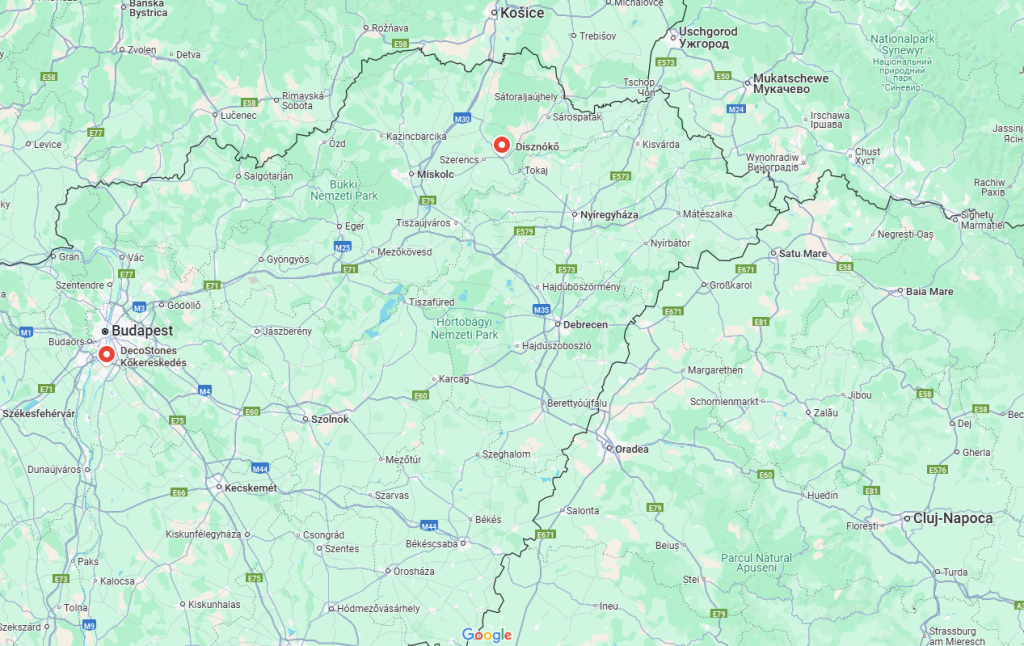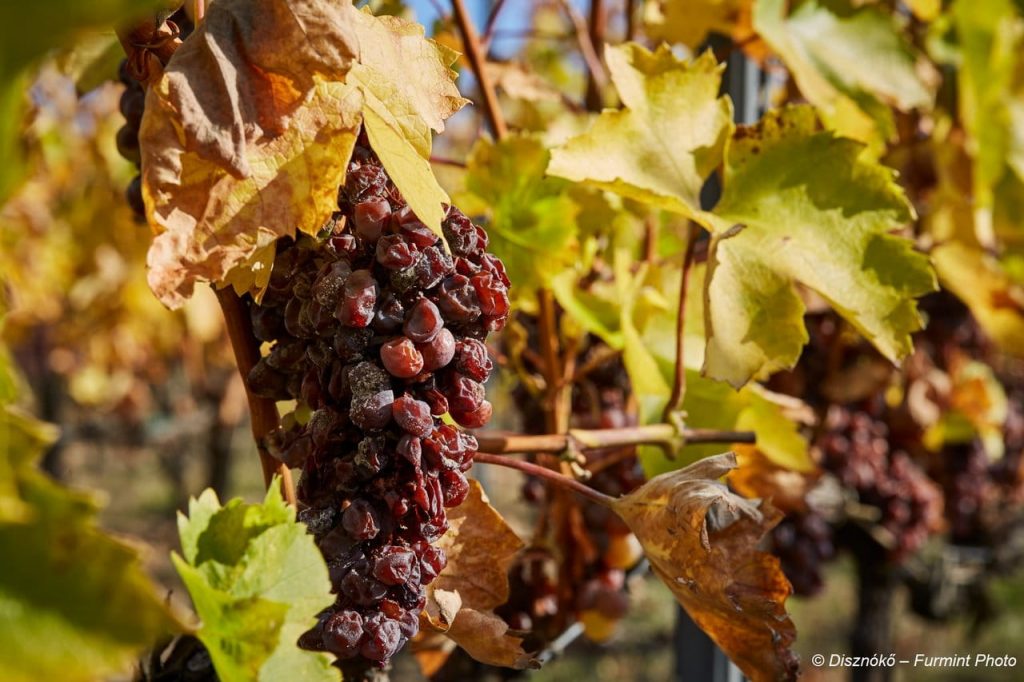In one of the most illustrious winemaking regions in the world, Diznókő is a shining example of both history and innovation, nestled among the undulating hills of Hungary’s Tokaj wine region. This four-century-old estate blends historical heritage with modern knowledge to produce wines that perfectly capture Tokaj’s distinct personality.

History of the Winery
The origins of Diznókő trace back to 1413, making it one of the oldest established vineyards in Tokaj. Named after the wild boars (“diznók” in Hungarian) that once roamed the surrounding forests, the estate’s lands were prized early on for their volcanic soils and ideal microclimate. Over the centuries, Diznókő experienced periods of prosperity and challenge, reflecting the broader history of Hungary itself. A significant transformation occurred in 1992 when AXA Millésimes, a French company renowned for its stewardship of prestigious wine estates across Europe, acquired the property. This investment ushered in a new era, marked by meticulous vineyard renewal, cellar modernization, and an emphasis on quality without compromising tradition.
Today, Diznókő represents both heritage and forward-thinking. Its cellars hold treasures from vintages past, while its vineyards remain the cornerstone of its enduring excellence.
Disznókő Winery
Hrsz. 0202 | Mezőzombor | 3931 Borsod-Abaúj-Zemplén County | Hungary
+36 47 569 410
eMail | disznoko.hu
Disznókő Winery on Google Maps | Instagram | X (Twitter)
The People
At the heart of Diznókő’s operations is a team that blends local knowledge with international experience. Managing Director László Márk and Chief Winemaker Gábor Kovács are among the key figures shaping the estate’s philosophy. Márk, with a deep understanding of Hungary’s wine industry and a passion for Tokaj’s potential, emphasizes sustainable viticulture and precision in both vineyard management and winemaking. Kovács, who trained both locally and abroad, brings technical prowess and an artisanal approach to the cellar, ensuring that every vintage expresses purity and complexity.
Together with their dedicated team, they share a common vision: to honor the traditions of Tokaj while adapting to the demands of modern wine connoisseurs. This balance between respect for history and openness to innovation positions Diznókő as a leader within Hungary’s contemporary wine scene.
Vineyards & Terroir
Diznókő’s vineyards extend across 104 ha of classified historic slopes, primarily situated on south-facing hillsides that maximize sunlight exposure. The estate benefits from Tokaji’s distinctive volcanic soils interspersed with loess and clay, contributing to the wines’ mineral complexity and structural finesse. Elevation variations and proximity to the Bodrog River create a unique microclimate conducive to the development of botrytis cinerea, essential for the production of Tokaji Aszú.
Each parcel within Diznókő is managed with precise attention to its specific conditions. From hand-harvesting to minimal intervention farming, the vineyard practices reflect a commitment to sustainability and the long-term health of the vines. The estate’s focus on preserving biodiversity and reducing chemical inputs is part of a broader strategy to protect the environment while enhancing grape quality. These efforts underscore Diznókő’s dedication to responsible stewardship of its historic lands.
Wine Portfolio
Diznókő’s wine portfolio captures the essence of Tokaji, ranging from dry expressions to the region’s iconic sweet wines. The flagship offerings include their Dry Furmint, a crisp, mineral-driven wine that showcases the purity of the grape and the influence of volcanic soils. Barrel fermentation and lees contact lend additional texture and complexity without overshadowing the variety’s natural freshness.
The estate’s hallmark, however, lies in its Tokaji Aszú wines. Crafted from meticulously selected botrytised grapes, these wines undergo a traditional process where the hand-picked aszú berries are macerated in a base wine before being aged in oak barrels within Diznókő’s centuries-old cellars. The result is a symphony of honeyed apricot, orange peel, and exotic spices, balanced by vibrant acidity and remarkable longevity. Bottlings include the celebrated 5 Puttonyos and 6 Puttonyos Aszú wines, symbols of Tokaj’s legendary sweet wine tradition.

Complementing these are Late Harvest wines, which offer an accessible introduction to Tokaj’s sweet styles, as well as innovative blends that explore modern expressions of classic varieties. Each bottle reflects the meticulous care invested from vineyard to cellar, embodying Diznókő’s philosophy of elegance and authenticity.
In the cellars of Diznókő, history, passion, and innovation coalesce. Every vintage carries forward the legacy of Tokaji, offering sommeliers, wine lovers, suppliers, and producers worldwide a taste of Hungary’s vinous heritage elevated by modern precision. Diznókő is not merely a winery; it is a testament to the enduring allure of Tokaj itself.
The Leading Wineries Shaping Tokaji’s Renaissance
In Hungary’s northeastern hills, the historic Tokaj region has long been associated with the golden sweetness of Tokaji Aszú, once known as “the wine of kings and king of wines.” Yet today, Tokaji is in the midst of a modern renaissance. Winemakers are not only perfecting their iconic sweet wines but also producing some of Central Europe’s most compelling dry whites, led by the native Furmint grape. From historic producers to visionary newcomers, these ten wineries exemplify Tokaji’s enduring quality and evolving style.
Royal Tokaji stands at the forefront of this revival. Founded in 1990 with the involvement of wine writer Hugh Johnson, Royal Tokaji helped reintroduce the world to Tokaji’s nobility after the collapse of communism. Today, its portfolio spans exceptional Aszú wines and increasingly sophisticated dry Furmint, reflecting both tradition and innovation.
Spanish investment has brought new energy through Oremus, part of the Vega Sicilia group. Oremus’s wines are known for their purity and finesse, especially its elegantly layered Aszú wines. From meticulous vineyard work to restrained cellar practices, Oremus exemplifies Tokaji’s potential for subtlety and refinement.
Any conversation about Tokaji must include István Szepsy. Often considered the architect of Tokaji’s modern rebirth, Szepsy has dedicated decades to understanding the intricacies of the region’s vineyards. His wines, both dry and sweet, are produced in small quantities but command respect worldwide for their depth, balance, and sense of place.
At Tokaj Hétszőlő, history meets sustainability. Situated on some of the region’s oldest classified vineyards, this organically farmed estate focuses on crafting wines of elegance and mineral precision, whether in its structured dry bottlings or in its carefully aged Aszú.
Meanwhile, Pajzos Megyer represents consistency and approachability. Long-established with vineyards in top sites, the winery produces wines that balance typicity with accessibility, from fresh dry wines to more traditional, richly textured sweet wines.
In contrast, Samuel Tinon offers a more artisanal approach. A French winemaker settled in Tokaji, Tinon champions small-batch production with a focus on terroir expression. His work with Szamorodni—an often-overlooked Tokaji style—brings attention to this complex, oxidative wine style.
A rising star in the region is Barta Pince, whose vineyards in the Öreg Király (Old King) site yield some of Tokaji’s most precise and focused wines. Single-vineyard Furmint from Barta showcaBartases volcanic minerality, while limited-production Aszú maintains the estate’s high standards.
Similarly, Demetervin is a boutique, family-run operation where minimal intervention and a strong connection to the land shape wines of purity and individuality. From structured dry Furmint to nuanced sweet wines, Demetervin’s production is small, yet its reputation continues to grow.
Finally, Dobogó, blending Hungarian heritage with New Zealand influence, crafts crisp, contemporary dry Furmints and youthful, fresh-style Aszú wines. Its international approach and clean winemaking style appeal to both modern palates and traditionalists alike.
Together, these ten wineries represent the best of Tokaji today: a region where centuries-old legacy coexists with dynamic innovation. Whether in a glass of golden Aszú or a mineral-driven dry Furmint, Tokaji’s winemakers are reminding the world why this corner of Hungary remains one of the wine world’s most fascinating places.